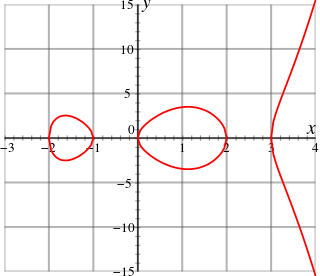Catalan's conjecture (or Mihăilescu's theorem) is a theorem in number theory that was conjectured by the mathematician Eugène Charles Catalan in 1844 and proven in 2002 by Preda Mihăilescu at Paderborn University. The integers 23 and 32 are two perfect powers (that is, powers of exponent higher than one) of natural numbers whose values (8 and 9, respectively) are consecutive. The theorem states that this is the only case of two consecutive perfect powers. That is to say, that

Jean-Pierre Serre is a French mathematician who has made contributions to algebraic topology, algebraic geometry and algebraic number theory. He was awarded the Fields Medal in 1954, the Wolf Prize in 2000 and the inaugural Abel Prize in 2003.
In mathematics, the Brauer group of a field K is an abelian group whose elements are Morita equivalence classes of central simple algebras over K, with addition given by the tensor product of algebras. It was defined by the algebraist Richard Brauer.
Ribet's theorem is part of number theory. It concerns properties of Galois representations associated with modular forms. It was proposed by Jean-Pierre Serre and proven by Ken Ribet. The proof was a significant step towards the proof of Fermat's Last Theorem (FLT). As shown by Serre and Ribet, the Taniyama–Shimura conjecture and the epsilon conjecture together imply that FLT is true.

Helmut Hasse was a German mathematician working in algebraic number theory, known for fundamental contributions to class field theory, the application of p-adic numbers to local class field theory and diophantine geometry, and to local zeta functions.

In mathematics, arithmetic geometry is roughly the application of techniques from algebraic geometry to problems in number theory. Arithmetic geometry is centered around Diophantine geometry, the study of rational points of algebraic varieties.
In mathematics, a field F is called quasi-algebraically closed if every non-constant homogeneous polynomial P over F has a non-trivial zero provided the number of its variables is more than its degree. The idea of quasi-algebraically closed fields was investigated by C. C. Tsen, a student of Emmy Noether, in a 1936 paper ; and later by Serge Lang in his 1951 Princeton University dissertation and in his 1952 paper. The idea itself is attributed to Lang's advisor Emil Artin.
This is a glossary of arithmetic and diophantine geometry in mathematics, areas growing out of the traditional study of Diophantine equations to encompass large parts of number theory and algebraic geometry. Much of the theory is in the form of proposed conjectures, which can be related at various levels of generality.
In mathematics, the Steinberg representation, or Steinberg module or Steinberg character, denoted by St, is a particular linear representation of a reductive algebraic group over a finite field or local field, or a group with a BN-pair. It is analogous to the 1-dimensional sign representation ε of a Coxeter or Weyl group that takes all reflections to –1.
In mathematics, the standard conjectures about algebraic cycles are several conjectures describing the relationship of algebraic cycles and Weil cohomology theories. One of the original applications of these conjectures, envisaged by Alexander Grothendieck, was to prove that his construction of pure motives gave an abelian category that is semisimple. Moreover, as he pointed out, the standard conjectures also imply the hardest part of the Weil conjectures, namely the "Riemann hypothesis" conjecture that remained open at the end of the 1960s and was proved later by Pierre Deligne; for details on the link between Weil and standard conjectures, see Kleiman (1968). The standard conjectures remain open problems, so that their application gives only conditional proofs of results. In quite a few cases, including that of the Weil conjectures, other methods have been found to prove such results unconditionally.
In mathematics, Deligne–Lusztig theory is a way of constructing linear representations of finite groups of Lie type using ℓ-adic cohomology with compact support, introduced by Pierre Deligne and George Lusztig.

Jonathan Lazare Alperin is an American mathematician specializing in the area of algebra known as group theory. He is notable for his work in group theory which has been cited over 500 times according to the Mathematical Reviews. The Alperin–Brauer–Gorenstein theorem is named after him.
In mathematics, the Artin conductor is a number or ideal associated to a character of a Galois group of a local or global field, introduced by Emil Artin as an expression appearing in the functional equation of an Artin L-function.
In mathematics, the analytic subgroup theorem is a significant result in modern transcendental number theory. It may be seen as a generalisation of Baker's theorem on linear forms in logarithms. Gisbert Wüstholz proved it in the 1980s. It marked a breakthrough in the theory of transcendental numbers. Many longstanding open problems can be deduced as direct consequences.
In mathematics, specifically in the field of group theory, the McKay conjecture is a conjecture of equality between the number of irreducible complex characters of degree not divisible by a prime number to that of the normalizer of a Sylow -subgroup. It is named after Canadian mathematician John McKay.

Pham Huu Tiep is a Vietnamese American mathematician specializing in group theory and representation theory. He is currently a Joshua Barlaz Distinguished Professor of Mathematics at Rutgers University.

Mikhail Vol'fovich Borovoi is a Soviet and Israeli mathematician. He has worked on Galois cohomology and on the arithmetic of linear algebraic groups, homogeneous spaces, Shimura varieties, and spherical varieties.
Semiabelian groups is a class of groups first introduced by Thompson (1984) and named by Matzat (1987). It appears in Galois theory, in the study of the inverse Galois problem or the embedding problem which is a generalization of the former.
The Brauer Height Zero Conjecture is a conjecture in modular representation theory of finite groups relating the degrees of the complex irreducible characters in a Brauer block and the structure of its defect groups. It was formulated by Richard Brauer in 1955.
Gabriel Navarro Ortega is a Spanish mathematician specializing in group theory, and representation theory of finite groups. Currently he is a full professor at the Universitat de València.







